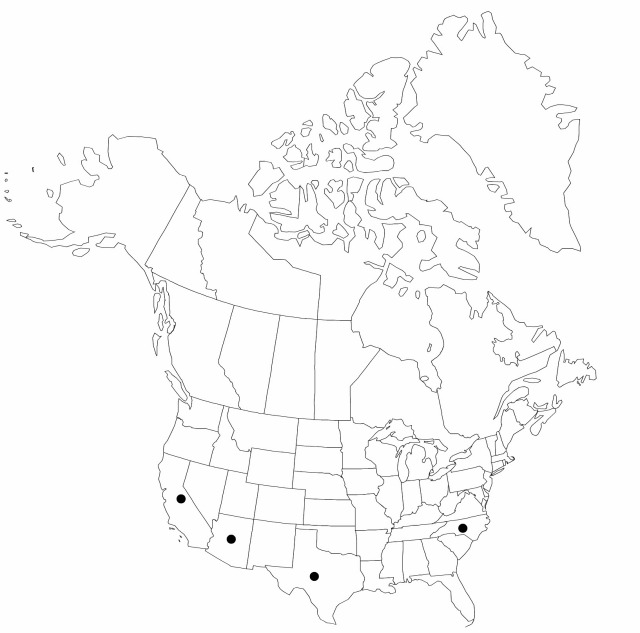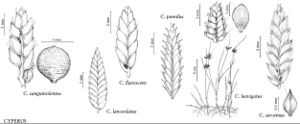Difference between revisions of "Cyperus laevigatus"
Mant. Pl. 2: 179. 1771.
FNA>Volume Importer |
GeoffLevin (talk | contribs) m (Corrected illegitimate name Cyperus niger to Cyperus melanostachyus in discussion) |
||
| (6 intermediate revisions by 2 users not shown) | |||
| Line 6: | Line 6: | ||
|place=2: 179. 1771 | |place=2: 179. 1771 | ||
|year=1771 | |year=1771 | ||
| + | }} | ||
| + | |special_status={{Treatment/ID/Special_status | ||
| + | |code=F | ||
| + | |label=Illustrated | ||
}} | }} | ||
|basionyms= | |basionyms= | ||
| Line 11: | Line 15: | ||
|name=Acorellus laevigatus | |name=Acorellus laevigatus | ||
|authority=(Linnaeus) Palla | |authority=(Linnaeus) Palla | ||
| + | |rank=species | ||
}} {{Treatment/ID/Synonym | }} {{Treatment/ID/Synonym | ||
|name=Chlorocyperus laevigatus | |name=Chlorocyperus laevigatus | ||
|authority=(Linnaeus) Palla | |authority=(Linnaeus) Palla | ||
| + | |rank=species | ||
}} {{Treatment/ID/Synonym | }} {{Treatment/ID/Synonym | ||
|name=Juncellus laevigatus | |name=Juncellus laevigatus | ||
|authority=(Linnaeus) C. B. Clarke | |authority=(Linnaeus) C. B. Clarke | ||
| + | |rank=species | ||
}} {{Treatment/ID/Synonym | }} {{Treatment/ID/Synonym | ||
|name=Pycreus laevigatus | |name=Pycreus laevigatus | ||
|authority=(Linnaeus) Nees | |authority=(Linnaeus) Nees | ||
| + | |rank=species | ||
}} | }} | ||
|hierarchy=Cyperaceae;Cyperus;Cyperus subg. Juncellus;Cyperus laevigatus | |hierarchy=Cyperaceae;Cyperus;Cyperus subg. Juncellus;Cyperus laevigatus | ||
| Line 35: | Line 43: | ||
|elevation=0–1000 m | |elevation=0–1000 m | ||
|distribution=Ariz.;Calif.;N.C.;Tex.;Mexico;West Indies;South America;Europe;Asia;Africa. | |distribution=Ariz.;Calif.;N.C.;Tex.;Mexico;West Indies;South America;Europe;Asia;Africa. | ||
| − | |discussion=<p><i>Cyperus laevigatus</i> is one of only two species of subg. Juncellus in the New World. It can be distinguished from all other New World species of <i>Cyperus</i> by its two stigmas and disclike, strongly flattened achene, which is borne with its face toward the rachilla. Species of subg. Pycreus, especially <i>C. | + | |discussion=<p><i>Cyperus laevigatus</i> is one of only two species of subg. <i>Juncellus</i> in the New World. It can be distinguished from all other New World species of <i>Cyperus</i> by its two stigmas and disclike, strongly flattened achene, which is borne with its face toward the rachilla. Species of subg. <i>Pycreus</i>, especially <i>C. melanostachyus</i>, have been misidentified as <i>C. laevigatus</i>, probably because of the dark, shiny spikelets. All species of subg. <i>Pycreus</i> have biconvex achenes like <i>C. laevigatus</i>; in species of subg. <i>Pycreus</i> the achene is attached with an edge toward the rachilla; in <i>C. laevigatus</i> the achene faces the rachilla.</p> |
|tables= | |tables= | ||
|references= | |references= | ||
| Line 44: | Line 52: | ||
-->{{#Taxon: | -->{{#Taxon: | ||
name=Cyperus laevigatus | name=Cyperus laevigatus | ||
| − | |||
|authority=Linnaeus | |authority=Linnaeus | ||
|rank=species | |rank=species | ||
| Line 58: | Line 65: | ||
|publication title=Mant. Pl. | |publication title=Mant. Pl. | ||
|publication year=1771 | |publication year=1771 | ||
| − | |special status= | + | |special status=Illustrated |
| − | |source xml=https:// | + | |source xml=https://bitbucket.org/aafc-mbb/fna-data-curation/src/2e0870ddd59836b60bcf96646a41e87ea5a5943a/coarse_grained_fna_xml/V23/V23_262.xml |
|genus=Cyperus | |genus=Cyperus | ||
|subgenus=Cyperus subg. Juncellus | |subgenus=Cyperus subg. Juncellus | ||
Latest revision as of 15:23, 15 November 2022
Herbs, perennial, rhizomatous. Culms single or close together, trigonous to ± terete, (1–)8–30(–60) cm × (0.3–)0.6–1.5(–2.2) mm, glabrous. Leaves: blades present or reduced to sheaths, base of culm covered with reddish sheath 5–25 mm, distally short toothed 1–2 mm, or leaf blades involute, 1–7 cm × 0.3–1(–1.6) mm. Inflorescences: heads appearing lateral, spikes ± digitate, 5–15 × 5–15 mm; rays absent, sometimes 1, to 2 mm; bracts (1–)2(–3), longer bracts erect, appearing as continuation of culm, shorter bract(s) horizontal or ascending, longer bracts (1–)2–8(–12) cm × 0.5–3 mm, shorter (0.3–)1–4.5 cm × 0.2–1 mm. Spikelets (1–)2–7(–14), whitish green to reddish, compressed-turgid, ellipsoid to oblong-lanceoloid, 4–7(–12) × (1.6–)2–3(–3.6) mm; floral scales (8–)12–22, off-white, whitish with red speckles, or with single red spot 0.5 mm wide, medially whitish, oblong-laterally ribless or weakly 2-ribbed, medially weakly 1–3-ribbed, obovate to orbiculate, 1.5–2 × (1.3–)1.6–2 mm. Flowers: anthers (0.5–)0.7–1 mm, connective apex reddish, 0.1–0.2 mm; styles 0.8–1.2 mm; stigmas 0.7–1 mm. Achenes gray, glossy, oblong-ellipsoid to ovoid, (1.2–)1.3–1.5(–1.8) × (0.7–)0.8–1(–1.2) mm, base cuneate to stipelike, apex apiculate, surfaces finely reticulate to papillate.
Phenology: Fruiting summer.
Habitat: Alkaline grasslands, hotsprings, ditches, brackish marshes
Elevation: 0–1000 m
Distribution

Ariz., Calif., N.C., Tex., Mexico, West Indies, South America, Europe, Asia, Africa.
Discussion
Cyperus laevigatus is one of only two species of subg. Juncellus in the New World. It can be distinguished from all other New World species of Cyperus by its two stigmas and disclike, strongly flattened achene, which is borne with its face toward the rachilla. Species of subg. Pycreus, especially C. melanostachyus, have been misidentified as C. laevigatus, probably because of the dark, shiny spikelets. All species of subg. Pycreus have biconvex achenes like C. laevigatus; in species of subg. Pycreus the achene is attached with an edge toward the rachilla; in C. laevigatus the achene faces the rachilla.
Selected References
None.
